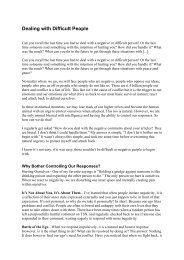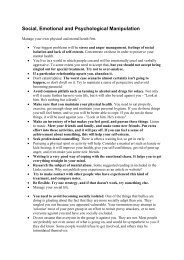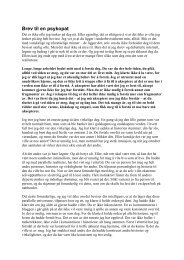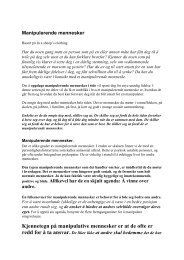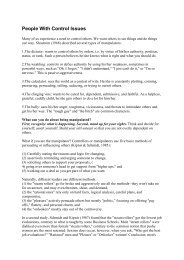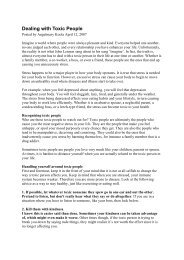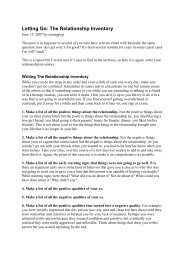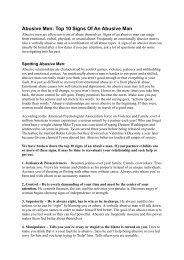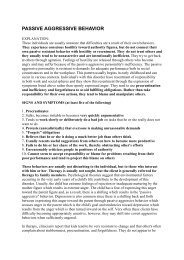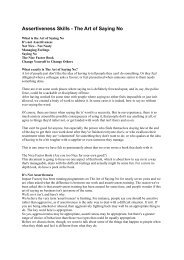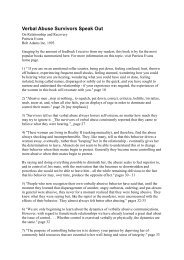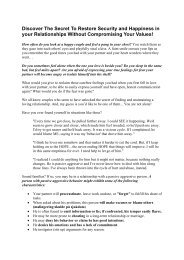Personality Disorders
Personality Disorders
Personality Disorders
You also want an ePaper? Increase the reach of your titles
YUMPU automatically turns print PDFs into web optimized ePapers that Google loves.
<strong>Personality</strong> <strong>Disorders</strong><strong>Personality</strong> disorders are patterns of perceiving, reacting, and relating to other peopleand events that are relatively inflexible and that impair a person's ability to functionsocially.Everyone has characteristic patterns of perceiving and relating to other people andevents (personality traits). That is, people tend to cope with stresses in an individual butconsistent way. For example, some people respond to a troubling situation by seekingsomeone else's help; others prefer to deal with problems on their own. Some people minimizeproblems; others exaggerate them. Regardless of their usual style, however, mentally healthypeople are likely to try an alternative approach if their first response is ineffective.In contrast, people with a personality disorder are rigid and tend to respondinappropriately to problems, to the point that relationships with family members,friends, and coworkers are affected. These maladaptive responses usually begin inadolescence or early adulthood and do not change over time. <strong>Personality</strong> disorders vary inseverity. They are usually mild and rarely severe.Most people with a personality disorder are distressed about their life and haveproblems with relationships at work or in social situations. Many people alsohave mood, anxiety, substance abuse, or eating disorders.People with a personality disorder are unaware that their thought or behavior patterns areinappropriate; thus, they tend not to seek help on their own. Instead, they may be referred bytheir friends, family members, or a social agency because their behavior is causing difficultyfor others. When they seek help on their own, usually because of the life stresses created bytheir personality disorder, or troubling symptoms (for example, anxiety, depression, orsubstance abuse), they tend to believe their problems are caused by other people or bycircumstances beyond their control.Until fairly recently, many psychiatrists and psychologists felt that treatment did not helppeople with a personality disorder. However, specific types of psychotherapy (talk therapy),sometimes with drugs, have now been shown to help many people. Choosing an experienced,understanding therapist is essential.<strong>Personality</strong> disorders are grouped into three clusters. Cluster A personality disordersinvolve odd or eccentric behavior; cluster B, dramatic or erratic behavior; and cluster C,anxious or inhibited behavior.
Consequences of <strong>Personality</strong> <strong>Disorders</strong>• People with a personality disorder are at high risk of behaviors that can lead tophysical illness (such as alcohol or drug addiction); self-destructive behavior, recklesssexual behavior, hypochondriasis, and clashes with society's values.• They may have inconsistent, detached, overemotional, abusive, or irresponsible stylesof parenting, leading to medical and psychiatric problems in their children.• They are vulnerable to mental breakdowns (a period of crisis when a person hasdifficulty performing even routine mental tasks) as a result of stress.• They may develop a mental health disorder; the type (for example, anxiety,depression, or psychosis) depends in part on the type of personality disorder.• They are less likely to follow a prescribed treatment regimen; even when they followthe regimen, they are usually less responsive to drugs than most people are.• They often have a poor relationship with their doctor because they refuse to takeresponsibility for their behavior or they feel overly distrustful, deserving, or needy.The doctor may then start to blame, distrust, and ultimately reject the person.Cluster A: Odd or Eccentric BehaviorParanoid <strong>Personality</strong>: People with a paranoid personality are distrustful and suspicious ofothers. Based on little or no evidence, they suspect that others are out to harm them andusually find hostile or malicious motives behind other people's actions. Thus, people with aparanoid personality may take actions that they feel are justifiable retaliation but that othersfind baffling. This behavior often leads to rejection by others, which seems to justify theiroriginal feelings. They are generally cold and distant in their relationships.People with a paranoid personality often take legal action against others, especially if theyfeel righteously indignant. They are unable to see their own role in a conflict. They usuallywork in relative isolation and may be highly efficient and conscientious.Sometimes people who already feel alienated because of a defect or handicap (such asdeafness) are more likely to suspect that other people have negative ideas or attitudes towardthem. Such heightened suspicion, however, is not evidence of a paranoid personality unless itinvolves wrongly attributing malice to others.Schizoid <strong>Personality</strong>: People with a schizoid personality are introverted, withdrawn, andsolitary. They are emotionally cold and socially distant. They are most often absorbed withtheir own thoughts and feelings and are fearful of closeness and intimacy with others. Theytalk little, are given to daydreaming, and prefer theoretical speculation to practical action.Fantasizing is a common coping (defense) mechanism.Schizotypal <strong>Personality</strong>: People with a schizotypal personality, like those with a schizoidpersonality, are socially and emotionally detached. In addition, they display oddities ofthinking, perceiving, and communicating similar to those of people with schizophrenia (seeSchizophrenia and Delusional Disorder: Schizophrenia). Although schizotypal personality issometimes present in people with schizophrenia before they become ill, most adults with aschizotypal personality do not develop schizophrenia.
Some people with a schizotypal personality show signs of magical thinking—that is, theybelieve that their thoughts or actions can control something or someone. For example, peoplemay believe that they can harm others by thinking angry thoughts. People with a schizotypalpersonality may also have paranoid ideas.Cluster B: Dramatic or Erratic BehaviorHistrionic (Hysterical) <strong>Personality</strong>: People with a histrionic personality conspicuously seekattention, are dramatic and excessively emotional, and are overly concerned with appearance.Their lively, expressive manner results in easily established but often superficial and transientrelationships. Their expression of emotions often seems exaggerated, childish, and contrivedto evoke sympathy or attention (often erotic or sexual) from others.People with a histrionic personality are prone to sexually provocative behavior or tosexualizing nonsexual relationships. However, they may not really want a sexual relationship;rather, their seductive behavior often masks their wish to be dependent and protected. Somepeople with a histrionic personality also are hypochondriacal and exaggerate their physicalproblems to get the attention they need.Narcissistic <strong>Personality</strong>: People with a narcissistic personality have a sense of superiority, aneed for admiration, and a lack of empathy. They have an exaggerated belief in their ownvalue or importance, which is what therapists call grandiosity. They may be extremelysensitive to failure, defeat, or criticism. When confronted by a failure to fulfill their highopinion of themselves, they can easily become enraged or severely depressed. Because theybelieve themselves to be superior in their relationships with other people, they expect to beadmired and often suspect that others envy them. They believe they are entitled to havingtheir needs met without waiting, so they exploit others, whose needs or beliefs they deem tobe less important. Their behavior is usually offensive to others, who view them as being selfcentered,arrogant, or selfish. This personality disorder typically occurs in high achievers,although it may also occur in people with few achievements.Antisocial <strong>Personality</strong>: People with an antisocial personality (previously calledpsychopathic or sociopathic personality), most of whom are male, show callous disregardfor the rights and feelings of others. Dishonesty and deceit permeate their relationships. Theyexploit others for material gain or personal gratification (unlike narcissistic people, whoexploit others because they think their superiority justifies it).Characteristically, people with an antisocial personality act out their conflicts impulsively andirresponsibly. They tolerate frustration poorly, and sometimes they are hostile or violent.Often they do not anticipate the negative consequences of their antisocial behaviors and,despite the problems or harm they cause others, do not feel remorse or guilt. Rather, theyglibly rationalize their behavior or blame it on others. Frustration and punishment do notmotivate them to modify their behaviors or improve their judgment and foresight but, rather,usually confirm their harshly unsentimental view of the world.People with an antisocial personality are prone to alcoholism, drug addiction, sexualdeviation, promiscuity, and imprisonment. They are likely to fail at their jobs and move fromone area to another. They often have a family history of antisocial behavior, substance abuse,divorce, and physical abuse. As children, many were emotionally neglected and physically
abused. People with an antisocial personality have a shorter life expectancy than the generalpopulation. The disorder tends to diminish or stabilize with age.Borderline <strong>Personality</strong>: People with a borderline personality, most of whom are women,are unstable in their self-image, moods, behavior, and interpersonal relationships. Theirthought processes are more disturbed than those of people with an antisocial personality, andtheir aggression is more often turned against the self. They are angrier, more impulsive, andmore confused about their identity than are people with a histrionic personality. Borderlinepersonality becomes evident in early adulthood but becomes less common in older agegroups.People with a borderline personality often report being neglected or abused as children.Consequently, they feel empty, angry, and deserving of nurturing. They have far moredramatic and intense interpersonal relationships than people with cluster A personalitydisorders. When they fear being abandoned by a caring person, they tend to expressinappropriate and intense anger. People with a borderline personality tend to see events andrelationships as black or white, good or evil, but never neutral.When people with a borderline personality feel abandoned and alone, they may wonderwhether they actually exist (that is, they do not feel real). They can become desperatelyimpulsive, engaging in reckless promiscuity , substance abuse, or self-mutilation. At timesthey are so out of touch with reality that they have brief episodes of psychotic thinking,paranoia, and hallucinations.People with a borderline personality commonly visit primary care doctors. Borderlinepersonality is also the most common personality disorder treated by therapists, because peoplewith the disorder relentlessly seek someone to care for them. However, after repeated crises,vague unfounded complaints, and failures to comply with therapeutic recommendations,caretakers—including doctors—often become very frustrated with them and view themerroneously as people who prefer complaining to helping themselves.Cluster C: Anxious or Inhibited BehaviorAvoidant <strong>Personality</strong>: People with an avoidant personality are overly sensitive to rejection,and they fear starting relationships or anything new. They have a strong desire for affectionand acceptance but avoid intimate relationships and social situations for fear ofdisappointment and criticism. Unlike those with a schizoid personality, they are openlydistressed by their isolation and inability to relate comfortably to others. Unlike those with aborderline personality, they do not respond to rejection with anger; instead, they withdraw andappear shy and timid. Avoidant personality is similar to generalized social phobia (seeAnxiety <strong>Disorders</strong>: Social Phobia).Dependent <strong>Personality</strong>: People with a dependent personality routinely surrender majordecisions and responsibilities to others and permit the needs of those they depend on tosupersede their own. They lack self-confidence and feel intensely insecure about their abilityto take care of themselves. They often protest that they cannot make decisions and do notknow what to do or how to do it. This behavior is due partly to a reluctance to express theirviews for fear of offending the people they need and partly to a belief that others are morecapable. People with other personality disorders often have traits of a dependent personality,but the dependent traits are usually hidden by the more dominant traits of the other disorder.
Sometimes adults with a prolonged illness or physical handicap develop a dependentpersonality.Obsessive-Compulsive <strong>Personality</strong>: People with an obsessive-compulsive personality arepreoccupied with orderliness, perfectionism, and control. They are reliable, dependable,orderly, and methodical, but their inflexibility makes them unable to adapt to change.Because they are cautious and weigh all aspects of a problem, they have difficulty makingdecisions. They take their responsibilities seriously, but because they cannot tolerate mistakesor imperfection, they often have trouble completing tasks. Unlike the mental health disordercalled obsessive-compulsive disorder (see Anxiety <strong>Disorders</strong>: Obsessive-CompulsiveDisorder (OCD)), obsessive-compulsive personality does not involve repeated, unwantedobsessions and ritualistic behavior.People with an obsessive-compulsive personality are often high achievers, especially in thesciences and other intellectually demanding fields that require order and attention to detail.However, their responsibilities make them so anxious that they can rarely enjoy theirsuccesses. They are uncomfortable with their feelings, with relationships, and with situationsin which they lack control or must rely on others or in which events are unpredictable.Other <strong>Personality</strong> TypesSome personality types are not classified as disorders.Passive-Aggressive (Negativistic) <strong>Personality</strong>: People with a passive-aggressive personalitybehave in ways that appear inept or passive. However, these behaviors are actually ways toavoid responsibility or to control or punish others. People with a passive-aggressivepersonality often procrastinate, perform tasks inefficiently, or claim an implausible disability.Frequently, they agree to perform tasks they do not want to perform and then subtlyundermine completion of the tasks. Such behavior usually enables them to deny or concealhostility or disagreements.Cyclothymic <strong>Personality</strong>: People with cyclothymic personality alternate between highspiritedbuoyancy and gloomy pessimism. Each mood lasts weeks or longer. Mood changesoccur regularly and without any identifiable external cause. Many gifted and creative peoplehave this personality type (see Mood <strong>Disorders</strong>: Cyclothymic Disorder).Depressive <strong>Personality</strong>: This personality type is characterized by chronic moroseness,worry, and self-consciousness. People have a pessimistic outlook, which impairs theirinitiative and disheartens others. To them, satisfaction seems undeserved and sinful. Theymay unconsciously believe their suffering is a badge of merit needed to earn the love oradmiration of others.DiagnosisA doctor bases the diagnosis of a personality disorder on a person's history, specifically, onrepetition of maladaptive thought or behavior patterns. These patterns tend to becomeapparent because the person tenaciously resists changing them despite their negativeconsequences. In addition, a doctor is likely to notice the person's immature and maladaptiveuse of mental coping mechanisms, which interferes with their daily functioning. A doctor mayalso talk with people who interact with the person.



